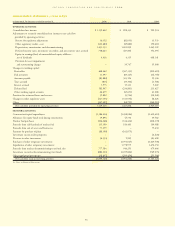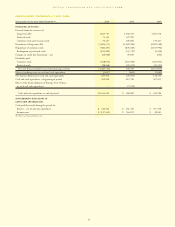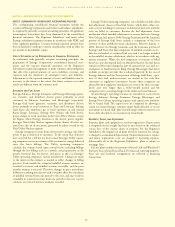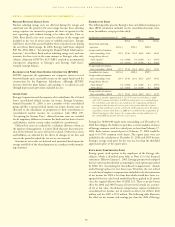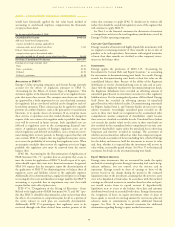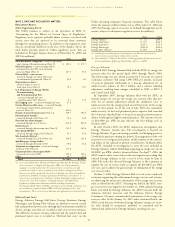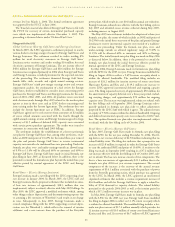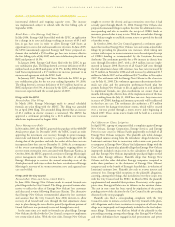Entergy 2006 Annual Report Download - page 76
Download and view the complete annual report
Please find page 76 of the 2006 Entergy annual report below. You can navigate through the pages in the report by either clicking on the pages listed below, or by using the keyword search tool below to find specific information within the annual report.
ENTERGY CORPORATION AND SUBSIDIARIES 2
2000066
60
DERIVATIVE FINANCIAL INSTRUMENTS AND COMMODITY DERIVATIVES
SFAS 133, “Accounting for Derivative Instruments and Hedging
Activities,” requires that all derivatives be recognized in the balance
sheet, either as assets or liabilities, at fair value, unless they meet the nor-
mal purchase, normal sales criteria. The changes in the fair value of
recognized derivatives are recorded each period in current earnings or
other comprehensive income, depending on whether a derivative is des-
ignated as part of a hedge transaction and the type of hedge transaction.
Contracts for commodities that will be delivered in quantities
expected to be used or sold in the ordinary course of business, includ-
ing certain purchases and sales of power and fuel, are not classified as
derivatives. These contracts are exempted under the normal purchase,
normal sales criteria of SFAS 133. Revenues and expenses from these
contracts are reported on a gross basis in the appropriate revenue and
expense categories as the commodities are received or delivered.
For other contracts for commodities in which Entergy is hedging the
variability of cash flows related to a variable-rate asset, liability, or fore-
casted transactions that qualify as cash flow hedges, the changes in the
fair value of such derivative instruments are reported in other compre-
hensive income. To qualify for hedge accounting, the relationship
between the hedging instrument and the hedged item must be docu-
mented to include the risk management objective and strategy and, at
inception and on an ongoing basis, the effectiveness of the hedge in off-
setting the changes in the cash flows of the item being hedged. Gains or
losses accumulated in other comprehensive income are reclassified as
earnings in the periods in which earnings are affected by the variability
of the cash flows of the hedged item. The ineffective portions of all
hedges are recognized in current-period earnings.
FAIR VALUES
The estimated fair values of Entergy’s financial instruments and deriv-
atives are determined using bid prices and market quotes.
Considerable judgment is required in developing the estimates of fair
value. Therefore, estimates are not necessarily indicative of the
amounts that Entergy could realize in a current market exchange.
Gains or losses realized on financial instruments held by regulated
businesses may be reflected in future rates and therefore do not accrue
to the benefit or detriment of stockholders. Entergy considers the car-
rying amounts of most financial instruments classified as current
assets and liabilities to be a reasonable estimate of their fair value
because of the short maturity of these instruments.
IMPAIRMENT OF LONG-LIVED ASSETS
Entergy periodically reviews long-lived assets held in all of its business
segments whenever events or changes in circumstances indicate that
recoverability of these assets is uncertain. Generally, the determination
of recoverability is based on the undiscounted net cash flows expect-
ed to result from such operations and assets. Projected net cash flows
depend on the future operating costs associated with the assets, the
efficiency and availability of the assets and generating units, and the
future market and price for energy over the remaining life of the
assets. See Note 13 to the financial statements for a discussion of asset
impairments recognized by Entergy in 2005 and 2004.
TRANSITION TO COMPETITION LIABILITIES
In conjunction with electric utility industry restructuring activity in
Texas, regulatory mechanisms were established to mitigate potential
stranded costs. Texas restructuring legislation allowed depreciation on
transmission and distribution assets to be directed toward generation
assets. The liability recorded by Entergy Gulf States as a result of this
mechanism is classified as “transition to competition” deferred credits
on the balance sheet. Entergy Gulf States has also recorded a corre-
sponding regulatory asset.
REACQUIRED DEBT
The premiums and costs associated with reacquired debt of Entergy’s
Utility operating companies and System Energy (except that portion
allocable to the deregulated operations of Entergy Gulf States) are
included in regulatory assets and are being amortized over the life of
the related new issuances, in accordance with ratemaking treatment.
NEW ACCOUNTING PRONOUNCEMENTS
FASB Interpretation No. 48, “Accounting for Uncertainty in Income
Taxes” (FIN 48) was issued in July 2006 and is effective for Entergy
in the first quarter of 2007. FIN 48 establishes a “more-likely-than-
not” recognition threshold that must be met before a tax benefit can
be recognized in the financial statements. If a tax deduction is taken
on a tax return, but does not meet the more-likely-than-not recogni-
tion threshold, an increase in income tax liability, above what is
payable on the tax return, is required to be recorded. Additional dis-
closure in the footnotes to the financial statements will also be
required for such liabilities. Entergy does not expect that the adoption
of FIN 48 will materially affect its financial position, results of oper-
ations, or cash flows. Entergy expects that the cumulative effect of the
adoption of FIN 48 will result in a reduction to consolidated retained
earnings at January 1, 2007 in the range of $3 million to $5 million.
In September 2006 the FASB issued Statement of Financial
Accounting Standards No. 157, “Fair Value Measurements” (SFAS
157) which defines fair value, establishes a framework for measuring
fair value in GAAP, and expands disclosures about fair value measure-
ments. SFAS 157 generally does not require any new fair value
measurements. However, in some cases, the application of SFAS 157
in the future may change Entergy’s practice for measuring and disclos-
ing fair values under other accounting pronouncements that require
or permit fair value measurements. SFAS 157 is effective for Entergy
in the first quarter of 2008 and will be applied prospectively. Entergy
is currently evaluating SFAS 157 and its potential future impacts on
its financial position, results of operations, and cash flows.
In February 2007 the FASB issued Statement of Financial
Accounting Standards No. 159, “The Fair Value Option for Financial
Assets and Financial Liabilities” (SFAS 159), which permits entities to
choose to measure many financial instruments and certain other items
at fair value. SFAS 159 is effective for Entergy in the first quarter
2008, and because of SFAS 159’s recent issuance Entergy's evaluation
is in its initial stages.
NOTESto CONSOLIDATED FINANCIAL STATEMENTS continued






